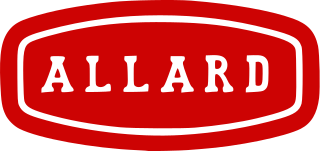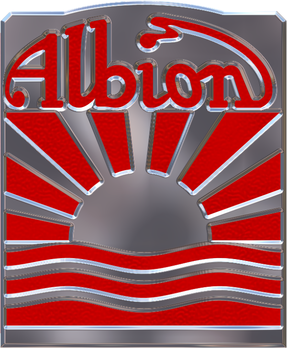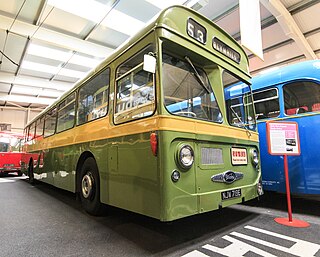
The Lotus Seven is a sports car produced by the British manufacturer Lotus Cars between 1957 and 1973. The Seven is an open-wheel car with two seats and an open top. It was designed by Lotus founder Colin Chapman and has been considered the embodiment of the Lotus philosophy of performance through low weight and simplicity. The original model was highly successful with more than 2,500 cars sold, due to its attraction as a road legal car that could be used for clubman racing.

AC Cars, originally incorporated as Auto Carriers Ltd., is a British specialist automobile manufacturer and one of the oldest independent car makers founded in Britain. As a result of bad financial conditions over the years, the company was renamed or liquidated many times until its latest form. In 2022, the new corporate structure began the production of new AC Cobra models, with a slightly modified structure to adapt it to modern safety and technology requirements and obtain the European road homologation certificate.

Allard Motor Company Limited was a London-based low-volume car manufacturer founded in 1945 by Sydney Allard in small premises in Clapham, south-west London. Car manufacture almost ceased within a decade. It produced approximately 1900 cars before it became insolvent and ceased trading in 1958. Before the war, Allard supplied some replicas of a Bugatti-tailed special of his own design from Adlards Motors in Putney.

The Lotus Europa name is used on two distinct mid-engine GT cars built by British automobile manufacturer Lotus Cars. The original Europa and its variants comprise the Lotus Types 46, 47, 54, 65 and 74, and were produced between 1966 and 1975.

The Ford Köln is an automobile that was produced by Ford Germany from 1933 until 1936 at its Cologne plant.

The Caterham 7 is a super-lightweight sports car produced by Caterham Cars in the United Kingdom. It is based on the Lotus Seven, a lightweight sports car sold in kit and factory-built form by Lotus Cars, from 1957 to 1972.

Berkeley Cars Ltd was a British car manufacturer based in Biggleswade, Bedfordshire. The company produced economical sporting microcars with motorcycle-derived engines from 322 cc to 692 cc and front wheel drive between 1956 and 1960. About 4,100 cars had been sold before bankruptcy in 1960.

The Ford Sidevalve is a side valve from the British arm of the Ford Motor Company, often also referred to as the "English Sidevalve". The engine had its origins in the 1930s Ford Model Y, and was made in two sizes, 933 cc (56.9 cu in) or "8 HP", and 1,172 cc (71.5 cu in) or "10 HP".
The Lanchester Motor Company Limited was a British car manufacturer in active trade between 1899 and 1955. Though the Lanchester Motor Company Limited is still registered as an active company and accounts are filed each year, the marque has been dormant since. As of 2014 it is marked as "non-trading".

The Austin 7 is an economy car that was produced from 1922 until 1939 in the United Kingdom by Austin. It was nicknamed the "Baby Austin" and was at that time one of the most popular cars produced for the British market and sold well abroad. Its effect on the British market was similar to that of the Model T Ford in the US, replacing most other British economy cars and cyclecars of the early 1920s. It was also licensed and copied by companies all over the world. The first BMW car, the BMW Dixi, was a licensed Austin 7. In France they were made and sold as Rosengarts, and in the United States they were built by the American Austin Car Company. In Japan, Nissan also used the 7 design as the basis for their first cars, although not under licence. This eventually led to a 1952 agreement for Nissan to build and sell Austins in Japan under the Austin name.

Albion Motors was a Scottish automobile and commercial vehicle manufacturer.

Dellow is a make of car which was produced in a factory owned by Delsons at Alvechurch, just south of Birmingham, England between 1949 and 1956.

Fairthorpe Ltd was a British manufacturer of motorcars, active between 1954 and 1973. Production was in Chalfont St Peter, Buckinghamshire, England between 1954 and 1961, from 1961 to 1973 in Denham, Buckinghamshire.

Gilbern, Gilbern Sports Cars (Components) Ltd , was a Welsh car manufacturer from 1959 to 1973, based in Llantwit Fardre, Pontypridd, Glamorgan, Wales.

The Daimler SP250 is a sports car built by the Daimler Company, a British manufacturer in Coventry, from 1959 to 1964. It was the last car to be launched by Daimler before its parent company, the Birmingham Small Arms Company (BSA), sold it to Jaguar Cars in 1960.

The Daimler Regency series was a luxury car made in Coventry by The Daimler Company Limited between 1951 and 1958. Only an estimated 49 examples of the 3-litre Regency chassis were made because demand for new cars collapsed just weeks after its introduction. Almost three years later in October 1954, a lengthened more powerful Regency Mark II (DF304) was announced but, in turn, after a production run of 345 cars, it was replaced by the very much faster, up-rated One-O-Four (DF310), announced in October 1955.

The Rover 12 was a name given to several medium-sized family cars from the British Rover car company between 1905 and 1948.

The Armstrong Siddeley Typhoon is a two-door, four-seat fixed-head coupé automobile produced by the British company Armstrong Siddeley from 1946 until 1949. It was based on the Armstrong Siddeley Lancaster saloon and continued the company's theme of naming cars after Hawker Siddeley World War II aircraft.

The Daimler DB18 is an automobile produced by Daimler from 1939 until 1953. It is a 2½-litre version of the preceding 2.2-litre New Fifteen introduced in 1937. From 1949, the DB18 was revised to become the Daimler Consort.

The Daimler Roadliner was a single-decker bus and coach chassis built by Daimler between 1962 and 1972. Notoriously unreliable, it topped the 1993 poll by readers of Classic Bus as the worst bus type ever, beating the Guy Wulfrunian into second place. It was very technologically advanced, offering step-free access some 20 years before other buses; as a coach, it was felt by industry commentators to be in advance of contemporary UK designs.



















